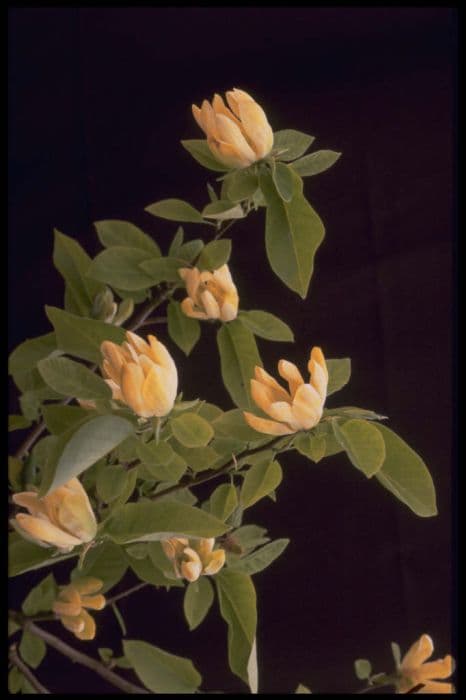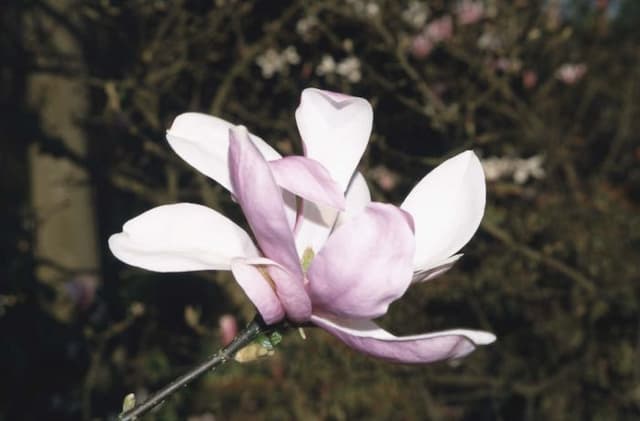Black Tulip Magnolia Magnolia Black Tulip = 'Jurmag1' (PBR)
![magnolia [Black Tulip]](/_next/image?url=https%3A%2F%2Fplants-admin.emdemapps.com%2Fimages%2Fplants%2F%2Fimages%2F604b590290fc7.png&w=3840&q=75)
ABOUT
The Magnolia Black Tulip, known for its richly colored, tulip-like flowers, presents a striking display in the landscape. This plant showcases dramatic blossoms that are deep burgundy-purple, almost black at times, revealing a unique and alluring appearance. Each flower is large and goblet-shaped, making a bold statement amidst the foliage when in bloom. The petals have a thick, leathery texture, contributing to their luxurious and sophisticated look. In contrast to the opulent blooms, the leaves are a lush green, which create a beautiful backdrop that further accentuates the flowers. The overall effect of the Magnolia Black Tulip's appearance is one of elegance and breathtaking beauty, often becoming the focal point of any garden where it's featured.
About this plant
 Names
NamesFamily
Magnoliaceae
Synonyms
Black Tulip Magnolia, Magnolia 'Black Tulip', 'Jurmag1' Magnolia
Common names
Magnolia Black Tulip = 'Jurmag1' (PBR)
 Toxicity
ToxicityTo humans
The Black Tulip Magnolia, often referred to as simply "Magnolia", is generally not considered toxic to humans. There are no well-documented cases of poisoning or severe adverse reactions from ingestion of this plant. However, as with any non-food plant, it is possible for individuals to experience mild stomach upset or an allergic reaction if any parts are ingested. Consuming plant parts is not recommended.
To pets
The Black Tulip Magnolia is not known to be toxic to pets. It is generally considered safe around pets, and there are no widespread reports of adverse effects from ingestion. Nonetheless, ingestion of leaves or flowers might still cause mild gastrointestinal upset in some animals, like vomiting or diarrhea, simply due to the consumption of non-digestible plant matter. It is always best to discourage pets from eating any plants to avoid any potential issues.
 Characteristics
CharacteristicsLife cycle
Perennials
Foliage type
Deciduous
Color of leaves
Green
Flower color
Burgundy
Height
10 feet (3 meters)
Spread
6 feet (2 meters)
Plant type
Tree
Hardiness zones
5
Native area
Mixed
Benefits
 General Benefits
General Benefits- Aesthetic Appeal: Features deep purple, tulip-shaped flowers that provide a unique and striking visual interest to any garden or landscape.
- Spring Blossoms: Blooms in early spring, offering an early splash of color after the winter months.
- Compact Size: With a relatively small and compact growth habit, it's suitable for smaller gardens or as a specimen plant in larger landscapes.
- Drought Tolerance: Once established, it has good resistance to drought, reducing the need for frequent watering.
- Low Maintenance: Requires minimal pruning and care once established, making it ideal for gardeners who prefer low-maintenance plants.
- Pest Resistance: Shows resistance to many common pests, decreasing the need for chemical treatments.
- Attracts Pollinators: The flowers attract bees and other pollinators, supporting local ecosystems.
- Year-Round Interest: Offers year-round interest with its attractive foliage, structure, and bark even when not in bloom.
 Medical Properties
Medical PropertiesThis plant is not used for medical purposes.
 Air-purifying Qualities
Air-purifying QualitiesThis plant is not specifically known for air purifying qualities.
 Other Uses
Other Uses- As a natural dye: The petals of the Black Tulip magnolia can be used to extract a natural dye for fabric, providing a range of purple to greenish hues depending on the mordant used.
- Culinary garnish: The flowers of the Black Tulip magnolia, while not commonly consumed, can be used as an elegant edible garnish in high-end culinary dishes, given that they are free of pesticides.
- Photography and Art: The striking deep purple, almost black flowers serve as a dramatic subject for photographers and artists, especially during the spring bloom.
- Wedding decorations: Black Tulip magnolia branches and flowers can be incorporated into wedding bouquets and centerpieces for a unique and sophisticated touch.
- Botanical studies: This variety can be used in educational settings for botanical studies due to its unique coloring and genetics, illustrating plant breeding techniques.
- Perfumery: Although not commonly exploited, the subtle fragrance of Black Tulip magnolia flowers could be used in crafting bespoke, natural perfumes.
- Eco-friendly confetti: The petals of the Black Tulip magnolia can be dried and used as biodegradable confetti for outdoor celebrations.
- Book pressing: The flowers and leaves of the Black Tulip magnolia can be used in flower pressing to create artistic bookmarks or to embellish hand-made greeting cards.
- Interior design elements: Dried Black Tulip magnolia flowers can be included in potpourri mixes or used in dried floral arrangements to add a dark, rich color contrast.
- Feng Shui: Some practitioners may use the plant in Feng Shui for its color attributes, which could symbolize depth, mystery, and focused energy in a given space.
Interesting Facts
 Feng Shui
Feng ShuiThe Magnolia is not used in Feng Shui practice.
 Zodiac Sign Compitability
Zodiac Sign CompitabilityThe Magnolia is not used in astrology practice.
 Plant Symbolism
Plant Symbolism- Perseverance and Endurance: The Magnolia Black Tulip is known for its ability to withstand tough conditions, symbolizing the ability to persist and endure challenges.
- Dignity and Nobility: With its bold appearance and graceful stature, this magnolia variety is often associated with dignity and a noble spirit.
- Feminine Beauty: Its lovely, tulip-shaped blooms are reminiscent of classic feminine beauty and sophistication.
- Love of Nature: The deep connection of the Magnolia Black Tulip to its native habitats signifies a love and appreciation of the natural world.
- Solitude and Reflection: Often found standing alone with striking flowers, it can represent contemplation and the value of solitude.
 Water
WaterBlack Tulip Magnolias require consistent moisture and should be watered deeply once a week, with adjustments made for particularly hot or dry weather. During the growing season in spring and summer, they may need water twice a week if conditions are very dry. Use one to two gallons of water per watering session to ensure the soil is moistened to a depth of about 10 inches, as this encourages deep rooting. In winter, reduce watering since the plant's water requirements decrease. Always check the soil moisture level before watering to avoid overwatering, which can lead to root rot.
 Light
LightThe Black Tulip Magnolia thrives in full sun to partial shade conditions. Planting it in a spot that receives at least six hours of direct sunlight per day is ideal for flower production and healthy growth. However, in hotter climates, some afternoon shade can be beneficial to protect the tree from intense, scorching sun.
 Temperature
TemperatureBlack Tulip Magnolias are hardy and best suited to a temperature range of 0 to 100 degrees Fahrenheit, but they can survive brief dips below freezing. They thrive in temperatures between 60 and 70 degrees Fahrenheit during the growing season. To ensure proper growth and bloom, avoid exposure to extreme heat or cold outside of this range.
 Pruning
PruningPrune Black Tulip Magnolias to remove dead or damaged wood and to shape the tree, best done in late winter or early spring before new growth emerges. Thinning out crowded branches every few years helps to maintain a healthy canopy. Annual light pruning is generally enough to keep the tree looking tidy. Pruning at the correct time helps prevent loss of the forthcoming year's blooms.
 Cleaning
CleaningAs needed
 Soil
SoilThe Black Tulip Magnolia prefers slightly acidic, well-draining soil with rich organic matter. A pH range between 5.5 and 6.5 is ideal. For potting, mix peat, compost, and a small amount of sand or perlite to enhance drainage. Maintaining consistent moisture without waterlogging is essential for this magnolia variety.
 Repotting
RepottingBlack Tulip Magnolias are typically grown outdoors and do not need regular repotting. When grown in containers, young trees may need repotting every 2-3 years to prevent becoming root-bound. Mature specimens may be top-dressed instead of being repotted.
 Humidity & Misting
Humidity & MistingThe Black Tulip Magnolia thrives in average outdoor humidity conditions. They do not require a particularly high humidity and can adapt to the humidity levels found in most temperate climates. Protection from strong winds can help maintain adequate humidity around the foliage.
 Suitable locations
Suitable locationsIndoor
Place in bright, indirect light and ensure large container.
Outdoor
Plant in moisture-retentive soil, sunny to part shade.
Hardiness zone
5-9 USDA
 Life cycle
Life cycleThe life cycle of the Magnolia 'Black Tulip' begins with germination from seed or establishment from a propagated cutting, developing a strong root system and initial shoot growth. As a juvenile, the plant grows rapidly, forming a sturdy trunk and branching structure. During its maturing phase, the tree expands its canopy, and during spring, it starts producing its distinctive tulip-shaped, dark purple to blackish flowers. After pollination, typically by beetles, it enters the reproductive stage, forming cone-like fruit aggregations that release red seeds when mature. Over time, the tree reaches full maturity and maintains a cycle of annual flowering and seed production. As it ages, growth slows and it may become more susceptible to environmental stresses and diseases until it eventually dies, completing its life cycle.
 Propogation
PropogationPropogation time
Spring-Early Summer
Magnolia Black Tulip, also known as 'Jurmag1', is typically propagated through softwood cuttings. This is the most popular method for propagating this particular cultivar. To propagate by cuttings, select a healthy, young branch in late spring to early summer when the plant's growth is most vigorous. Cut a 4-6 inch (about 10-15 cm) section from the tip of the branch, making sure that it includes at least two sets of leaves. Dip the cut end of the cutting into a rooting hormone powder to encourage root development and plant it in a well-draining potting mix. The cutting should be kept in a warm, humid environment with indirect light. Rooting can take several weeks, during which the cutting should be kept moist but not waterlogged. Once rooted, the new plant can be transplanted into the garden.









